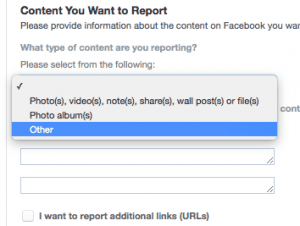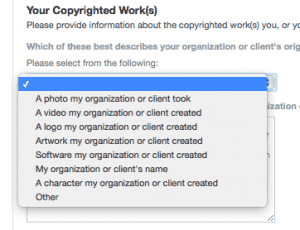Deconstructing Facebook’s Copyright Form
 In May, Facebook announced that it was introducing Instant Articles, which would allow publishers to upload and host content directly on Facebook’s site rather than merely share links, images and snippets.
In May, Facebook announced that it was introducing Instant Articles, which would allow publishers to upload and host content directly on Facebook’s site rather than merely share links, images and snippets.
Reactions to the announcement have been varied ranging from people calling it “The slow death of the open web” to calling it a revolution for the web.
However, this isn’t the first time that Facebook has moved to have more content published its platform rather than the outside web. The company’s video feature has often been criticized for encouraging piracy by showing favoritism to Facebook-hosted content over original content hosted elsewhere. This has been backed up by countless videos that were ripped from YouTube and other sites only to be uploaded on Facebook and receive millions of views.
But as Facebook begins encouraging more and more content to be uploaded onto its platform, it’s copyright policies come more and more into focus. Unfortunately though, as someone who sends Digital Millennium Copyright Act (DMCA) notices to Facebook semi-regularly, the process is less-than-ideal, especially for newcomers and content creators of certain types.
To understand Facebook’s issues, we first have to look at the process for filing a DMCA notices and how it’s form fails to live up to industry standards.
Filing a DMCA Through Facebook
If you found a photo, article or other content of yours on Facebook without your permission and want it removed, Facebook has a DMCA process.
If you’re new to the process and you’re already in Facebook, you can just search for “copyright” in the Help menu. If you’re not in Facebook, a quick search for Facebook DMCA leads you to this page, which has largely the same material as the help entry.
From there, among the other links, there are two that are useful. The first is a link to contact the designated agent directly. This can work well if you are familiar with the DMCA process and have a good stock DMCA notice already. However, bear in mind it will likely be slower than using the form as it requires more human involvement.
As such, if you’re new to the process or want the quickest resolution possible, you’ll probably want to seek out the Facebook DMCA form.
From there, the form walks you through an 5 step process for filing a single notice.
- Confirm It is a Copyright Issue: The form first has you select and then verify that it is a copyright issue and not a different abuse issue.
- Re-Confirm It is a Copyright Issue: You are then taken to a list of reasons as to why you are filing the notice, basically to re-confirm this is a copyright issue. The “correct” answer is in the middle of the list.
- Enter Contact Information: You must provide all relevant contact information for yourself as the DMCA filer including name, mailing address, phone number and email.
- Identify the Content You Wish to Report: Provide URLs and other information about the content that is infringing.
- Describe the Work Being Infringed: Finally you have to describe the work that’s being infringed, including a description of it and, if possible, a link to where it can be found legitimately.
All in all, this doesn’t seem too bad. Other than the duplicative confirmation that it is a copyright infringement report, the process pretty closely follows what one would expect to do with a regular DMCA request, just in a form.
However, with the Facebook process, the devil is in the details and some of those details get pretty messy.
The Problems with the Form
 Right off the bat, the DMCA form wastes no time in wasting time. It not only double confirms that the issue is a copyright one, but buries the “I found content which I believe violates my copyright” answer among answers about being bullied and account hacking.
Right off the bat, the DMCA form wastes no time in wasting time. It not only double confirms that the issue is a copyright one, but buries the “I found content which I believe violates my copyright” answer among answers about being bullied and account hacking.
While, in my work with web hosts, I understand completely that users often use the DMCA agent address for issues other than copyright ones, there isn’t a clear reason for asking the same question twice, the second time in a confusing manner.
That being said, the form itself gets in the way of itself when it comes to describing the infringing content. It asks you to first select the type of content that you are reporting but lumps photos, videos, notes, shares, wall posts and files into one category. Only photo albums and “Other” are broken out separate.
This strikes me as bizarre because nearly all content on Facebook would be in the first category and the separation of photos and photo albums seems duplicative. If I have a dozen images to report, do I say photos or photo albums? It’s not particularly clear.
The form then requires that you get the specific URL of the content you’re reporting, which is more than reasonable but the process for doing so is not straightforward and Facebook provides no guidance for doing it on the form itself. Instead, Facebook provides an alternate method that involves getting the name, closest URL possible, the date, and the description of the content.
Why Facebook doesn’t simply provide instructions to get the URL is unclear to me as most items do have a usable URL.
Also interesting is that Facebook provides single-URL boxes for the first three but a text box that can handle as many as you need for any overflow. It’s an interesting user interface decision that makes it unclear why the first three need to be broken out.
 Finally, when you go to identify the original work, you’re asked to select the type of content that you’re trying to report. The list includes photos, videos, logos, artwork, software, company name and a character.
Finally, when you go to identify the original work, you’re asked to select the type of content that you’re trying to report. The list includes photos, videos, logos, artwork, software, company name and a character.
What is interesting with this list is not just that the list is another check to ensure that it is a copyright issue being filed over, but the omission of any text works. Considering the most common thing I file over is plagiarized marketing copy used by competitors, I have to select other, which requires me to further describe the work involved.
Why a major content type is missing from this form is unclear.
In short, Facebook’s DMCA form is confusing, repetitive, omits one of the most common types of content and has the user jump through unneeded hoops. While the form is far, far, far from the most egregious I’ve seen (I can name several cyberlocker sites with intentionally obtuse and hindering DMCA forms), it’s still beneath what Facebook should be capable of.
Defending Facebook
To be completely fair to Facebook, I don’t believe that these problems are malicious. I say that in part because I’ve seen what malicious interference with copyright notices looks like, but also because the problems are, for the most part, limited to the interface.
Once you’re able to get a complete DMCA notice off to Facebook, they do respond quickly, probably the fastest of any major web company. I usually get responses within 12-24 hours from them, much faster than Google or other companies of similar size. Only rarely have I seen notices not get action and it’s usually because of confusion on the part of the person handling it.
In short, when it comes to doing the work of processing a notice, Facebook is very solid, the problem is the submission of the notice.
Even that might not bother me too much, but this is Facebook we are talking about. Facebook is a company that is known for being very deliberate with its interface (for better or worse) and is an expert and presenting users large amounts of information in a digestible way.
The Facebook copyright form, however, shows the exact opposite, a complete lack of thought and care in the copyright complaint process.
Several years ago, when most of the content was behind the walled garden, that might not have been as big of a deal. But Facebook is gradually moving to be more than just a social network but a publishing and hosting platform as well. Not only does nearly every business, celebrity, website and organization have a public page, but they’re adding video and article hosting to the mix.
If Facebook is going to be the platform of the future, it needs a copyright reporting system to match (which I think should include a full transparency report). Even as Google has invested heavily in its copyright reporting process, with mixed results, Facebook is stuck with a poorly-thought out process that makes things more difficult for filers and, most likely, its staff.
It’s something so simple, but yet it’s been so heavily neglected.
Bottom Line
In a time where companies like Hostgator and Automattic have simple, straightforward DMCA forms, there’s not much reason why Facebook couldn’t do the same. Though I have issues with Google’s form, even it is preferable to Facebook’s.
Yes, there are unique challenges to creating such a form for Facebook, including the sheer amount of unique content types the service has, but the system it has now could be greatly streamlined to everyone’s benefit.
The problem isn’t that Facebook wishes to thwart content creators, it’s that it hasn’t put the thought and care into this process that it has other parts of its site. Like many other sites and hosts, this part of operating a service has been neglected.
But now that Facebook is on the cusp of a reinvention, now is the best time to fix that. Not just to improve things for everyone involved, but to help ensure that their site’s culture is one of original content, not just content repurposed from elsewhere.
Want to Reuse or Republish this Content?
If you want to feature this article in your site, classroom or elsewhere, just let us know! We usually grant permission within 24 hours.
